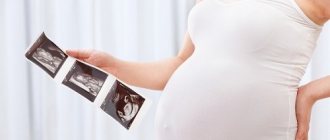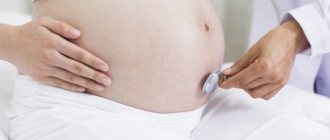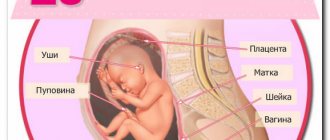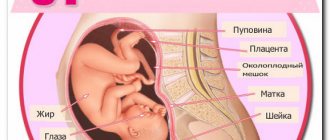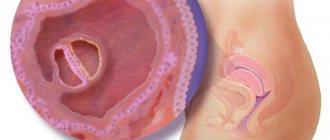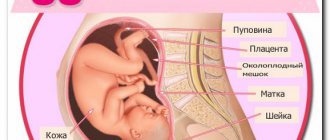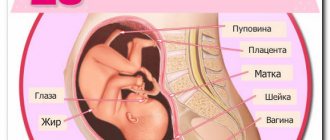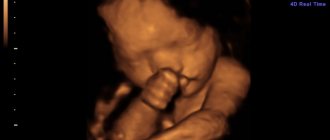Every day of a pregnant woman is felt with trepidation and excitement. After 4 weeks, the expectant mother may not even be aware of her situation, because her appearance has not changed at all. But inside the body undergoes enormous changes. To monitor this, they attend an ultrasound examination.
Why and why an ultrasound procedure is performed at the 4th week (6th obstetric) of pregnancy, we will explain in this article.
4th week of pregnancy - how many months is it?
The gestational age can be:
| Term | Description |
| Embryonic | It is also called embryonic. It corresponds to the time that has passed since the estimated moment of conception. It can be calculated approximately, since the exact date of fertilization cannot be determined. |
| Obstetric | Calculated from the start of the last menstruation. This calculation method is more accurate and is used in modern obstetrics. The doctor uses this method to determine the expected date of birth. |
Since the 14th day from the beginning of the last menstruation (the day of ovulation) is considered favorable for conception, the difference between the embryonic and obstetric periods is 2 weeks. The 4th week from conception is equal to the 6th obstetric week. The length of obstetric and calendar weeks is the same.
4 weeks of pregnancy from conception is the period from 21 to 28 days of the 1st calendar month of pregnancy or the 6th obstetric week is the period from the 7th to 14th day of the 2nd lunar month of pregnancy.
32–34 weeks
During this period, the woman undergoes the third pregnancy screening. In addition, starting from the 32nd week of pregnancy with twins, the patient can take sick leave for the prenatal and postpartum period.
Prenatal screening consists of two stages:
- CTG;
- Ultrasound
Cardiotocography is an examination method in which the doctor examines the heart rate of twins, their motor activity, and the tone of the woman’s uterus.
An ultrasound examination will provide information about malformations that are detected in late pregnancy and will allow us to assess the presence of direct indications for cesarean section. This may be a transverse presentation of one or both fetuses, partial or complete placenta previa, entwining the cervix of one baby or twins with the umbilical cord.
External signs of pregnancy
By this period, the woman’s body had time to do the work, creating comfortable conditions for the formation of the future person, but pregnancy did not have a noticeable effect on her appearance.
The woman's figure retains the same outline. The stomach remains flat, although sometimes the expectant mother may notice that it is somewhat rounded. The reason for this is the accumulation of gases in the intestines, as a result of the effect of the hormone progesterone, which is responsible for maintaining pregnancy, on the digestive system.
The breasts may grow by 1 size and the bra, which previously fit, becomes too small. Enlargement of the mammary glands is accompanied by darkening of the nipples and the gradual appearance of a clear venous pattern on the skin: the breasts are preparing for feeding.
Sometimes dark spots appear on the face and body, which is associated with an increase in the amount of melanin in the cells of the epidermis under the influence of hormones.
Is it possible to fly on an airplane?
Flying during the 4th week of pregnancy is often contraindicated. This is associated with the following conditions:
- severe toxicosis, accompanied by frequent vomiting;
- threat of miscarriage;
- leakage of amniotic fluid;
- exacerbation of chronic diseases;
- anemia.
During this period, the body already endures a colossal load and many changes. It is better for a woman to be at home in a familiar environment.
Feelings of the expectant mother
4 weeks of pregnancy from conception are characterized in women by various sensations caused by changes in hormonal levels and the gradual growth of the uterus.
These are, in particular:
- constant fatigue;
- drowsiness;
- fast fatiguability;
- irritability;
- frequent migraines;
- increased salivation;
- a feeling of heaviness in the mammary glands and soreness of the nipples; in women with a small bust size, nagging pain in the chest is possible;
- in the morning - mild nausea, sometimes vomiting (a consequence of early toxicosis);
- increased urge to empty the bladder;
- sensitivity to smells and changes in taste preferences;
- nagging pain in the lower abdomen. They can be caused by a growing uterus, which puts more pressure on nearby internal organs and creates stress on muscles and ligaments.
Methods of conducting research
The most effective method of obtaining reliable information is transvaginal ultrasound. During which the doctor inserts an ultrasound probe into the vagina. It does not require any preparatory measures. The only condition is that the bladder is empty. However, for the use of this type of study, colpitis and vaginitis in the acute stage are considered contraindications. In this scenario, a transabdominal ultrasound will be recommended.
A transabdominal scan is carried out through the woman’s abdominal cavity; it allows you to see the first image of the baby, which looks like a formation that has a round or elongated shape. If future parents have a desire, they can receive the first photo of the baby. For information, at four weeks of pregnancy it is not recommended to conduct examinations in 3D, 4D format.
Research using the transabdominal method requires some preparatory measures. If a woman suffers from flatulence, then for 3 days she may be recommended a special diet that excludes the consumption of foods that increase gas formation in the intestines.
These include:
How many times can an ultrasound be done throughout pregnancy?
- cabbage;
- tomatoes;
- fresh vegetables;
- juices;
- sweets;
- fresh bakery;
- legumes
In addition, before scanning, it may be recommended to use activated carbon, Espumisan. Ultrasound diagnostics are also performed when the bladder is full. This allows you to elevate the uterus for better visualization. If ultrasound diagnostics do not determine the presence of pregnancy, the patient is recommended to undergo a re-examination after 14 days. This is possible with a difficult to detect intrauterine, frozen pregnancy.
The vaginal method provides more accurate information
Discharge
Normally, weak vaginal discharge is present in any woman, but pregnancy makes its own adjustments. More intense blood supply to the pelvic organs leads to an increase in the volume of leucorrhoea - a clear, colorless liquid with a weak sour odor. There may also be an increase in the amount of mucous discharge, sometimes acquiring a faint yellowish color.
Some women report weak and short-term bleeding from the vagina after sexual intercourse. Their probable cause is microtrauma of the vaginal walls, which become more vulnerable during pregnancy.
However, if such discharge is constant, profuse, or accompanied by pain, a doctor’s consultation is necessary. They may be caused by erosion, tumors, or polyps that need to be removed before delivery.
An urgent visit to the antenatal clinic is necessary if:
- excessive vaginal discharge;
- unpleasant odor;
- burning;
- itching;
- feeling of discomfort;
- painful sensations.
Particular attention should be paid to their color and consistency, in particular:
- white, thick discharge resembling cottage cheese is a clear sign of thrush;
- having an unpleasant odor, abundant dark yellow discharge indicates the development of an inflammatory process in the vagina;
- green discharge with a lot of mucus is one of the symptoms of a dangerous bacterial infection;
- watery discharge with a gray tint and a fishy odor is a symptom of bacterial vaginosis;
- foamy leucorrhoea mixed with pus, causing redness of the vaginal tissues and the appearance of grayish spots on them - a sign of trichomoniasis.
It is important to remember: the weakened immune system characteristic of pregnancy creates conditions for the development of various infections, so you should be attentive to any discharge.
A visit to the antenatal clinic, and sometimes an emergency call, is required by bloody discharge:
- bright scarlet;
- brown;
- pink.
Especially if they are accompanied by the following symptoms:
- pain;
- weakness;
- frequent fainting.
In the middle of the 1st trimester of pregnancy they can be caused by:
- miscarriage;
- ectopic pregnancy;
- bleeding that occurs when the embryo attaches to the walls of the uterus (implantation);
- frozen pregnancy;
- in case of multiple pregnancy - loss of one of the embryos;
- detachment of the chorion (embryonic membrane);
- tetrochorionic hematoma is a blood-filled cavity located between the wall of the uterus and the tissues responsible for feeding the embryo. A hematoma, interfering with the flow of nutrients, increases the risk of miscarriage.
However, not all bleeding indicates the listed factors and are dangerous, but if they are present, you should immediately consult a doctor. Only a specialist can determine the cause, decide on the appropriateness of certain measures and prescribe treatment.
Methods for fertilizing twins and triplets
The predisposition to multiple pregnancies, scientifically called polyembryony, has not been fully studied. But biologists have identified a number of factors that contribute to double and triple fertilization:
- IVF procedure. During artificial conception, a woman is stimulated to produce more eggs. Therefore, in one cycle, 2 ovaries produce eggs at once. Different sperm fertilize them.
- Genetic predisposition. One of the spouses was born a twin or twin. It is transmitted only through the female line.
- Hormonal changes in the female body after 35 years. Because of this, ovulation occurs in two ovaries at once.
- Abnormal structure of the uterine cavity.
- A high level of a hormone in the blood that stimulates the maturation of follicles. Two or more eggs are produced at the same time.
3D ultrasound of twins
How to get pregnant with twins
It is most likely possible to become pregnant with twins through in vitro fertilization. The procedure is carried out only according to indications:
- unexplained infertility over a long period;
- the woman had her fallopian tubes removed;
- there are genetic mutations that are inherited;
- non-viable or inactive sperm in a man;
- obstruction in the fallopian tubes.
IVF is not done for women who are 40 years of age or older. During the procedure, the doctor removes one chromosome from the sperm. The father's chromosome influences the child's gender. Afterwards, the female egg is fertilized by a male sperm, in which the gender of the baby is determined in advance.
Watch a video on how to get pregnant with twins:
Fertilization often occurs simultaneously on several eggs, since one of them may die. But if both survive, the pregnancy results in twins or triplets.
How do you get twins without outside intervention?
Pregnancy with twins without outside intervention is due to a genetic predisposition:
- Fraternal twins are obtained if one egg is fertilized by two sperm or two eggs mature in one cycle.
- Identical twins are formed when an egg splits into two zygotes. Both particles carry an identical gene set. That's why twins are born identical.
Pregnancy with twins is always a joy, but a woman should be prepared for double the load. For pregnant women with two or more fetuses, there are special conditions that they adhere to throughout pregnancy. Twins and triplets are born earlier than single babies.
Do you have any questions on the topic? Share your opinion about twin pregnancy in the comments. Tell your friends about the article on social networks.
Fetal development
By the 4th week of intrauterine development, the embryo settled comfortably in the uterus, attached itself to its wall and received the right to be called an embryo.
In accordance with the terminology accepted in obstetrics, the embryo stage lasts from the moment of fertilization until the moment of attachment of the fertilized egg to the wall of the uterus. Further, until the beginning of the 8th week of pregnancy - the embryo stage, after which the future person turns into a fetus.
The placenta is compacted and strengthened, an umbilical cord has formed, and now the baby receives nutrition not from the yolk sac, as before, but directly from the mother’s body. The development process that started in previous weeks continues: the future person is rapidly growing, changing and being formed.
Size and weight
The dimensions of the fertilized egg by the beginning of the 4th week reach 2.5 cm, and the “height” of the baby is 4 mm, its weight is about 1 g. By the end of this period, the height will increase to 10 mm, and the weight will increase to 1.5 grams
Nervous system
The nervous system of the unborn child is actively developing:
- the neural tube is formed, from which the central and peripheral nervous system will subsequently develop;
- the first connections appear between neurons;
- nerve cells are actively dividing, forming brain vesicles, which will later turn into parts of the brain;
- a network of blood vessels grows, which will feed it in the future.
Internal organs
4 weeks of pregnancy from conception are characterized by an important sign - the beginning of the fetal heart.
It resembles a tube, the walls of which pump blood through the vessels and contract at a frequency of 120 beats per minute. This is twice the rate at which the heart muscle of an adult works. By the end of the week, he will have 2 chambers - the future atrium and ventricle, between which a septum will gradually form.
Other organs are also laid down:
- intestines;
- bladder;
- liver;
- lungs.
The skull is formed, the rudiments of the future skeleton appear. The digestive, genitourinary and immune systems begin to work. The child, having passed the milestone of 4 weeks of intrauterine life, accelerates the rate of growth and development.
Appearance
The embryo still bears little resemblance to a human being. The neck has not yet formed, but the head is already clearly visible and there are depressions in the place of future eyes, ears, mouth, there are 2 microscopic nostrils in the place where the nose will later appear.
This is what the fetus looks like at 4 weeks of pregnancy
The tail is still present, but has already become shorter than it was in previous weeks: a little more time will pass and it will disappear completely. 4 protuberances appear on the tiny body: they will later turn into arms and legs.
The external genital organs have not yet been formed, the labial-scrotal folds from which they will develop still look the same in boys and girls, so it is not yet possible to determine the sex of the child.
Pain in the lumbar region
In the lumbar region, pulling and discomfort in the 4th week can occur due to various reasons. It is normal if these pains are moderate and there is passing coughing. Usually this indicates an increase in the size of the uterus and preparation of the osseous-ligamentous apparatus for bearing a baby.
Causes of pathological pain include:
- excess body weight and increased load on the spine;
- diseases of the spinal column that occurred before pregnancy;
- kidney pathologies.
If you notice such pain and its dynamics increase, you should definitely consult a doctor. Timely diagnosis of certain problems will help eliminate many complications in the future.
Scheduled doctor visits
4 weeks after conception is the point when the absence of menstruation finally convinces a woman that she is pregnant. This is the time to visit an antenatal clinic and register.
At the 1st appointment, the obstetrician:
- will conduct an oral conversation in order to establish the duration of pregnancy, health status, the presence of chronic diseases, complaints and when the date of the last menstruation began;
- will perform an examination in a chair, which will identify pathologies at an early stage and confirm the fact of pregnancy (although outwardly the woman’s figure remains the same, the gynecologist can already determine that the uterus is enlarged);
- prescribe the necessary tests and examinations;
- will create an exchange card in which data on the course of pregnancy will be entered before the birth;
- will set the date for the next visit: if the expectant mother feels well and has no health problems, she will have to come for routine examinations once a month until she is 28 weeks pregnant.
As a rule, during subsequent scheduled visits, an examination in a chair is not performed; the pregnant woman’s abdominal volume and weight are measured, the fetal heartbeat is determined, and general recommendations are given.
Due date for multiple pregnancies: when do they give birth?
A multiple pregnancy differs from a normal pregnancy in many ways. Mother Nature, in caring for babies and their mother, usually orders that labor begins before 40 weeks. Therefore, although twins are usually smaller in weight and height than normal children, their lungs open earlier.
Harbingers of childbirth
The first warning sign of labor is abdominal prolapse.
The woman notices that it has become easier for her to breathe, as the pressure of the uterus on the diaphragm has decreased. But it can take up to two weeks from the moment the uterus prolapses until delivery. Shortly before birth, the pelvic bones and lower back may begin to develop. The ligaments are separated to facilitate the birth of babies. Unusual discharge may turn out to be a mucus plug - this is a harbinger that there are from several days to several hours left before the birth.
At what week is it considered full term?
Twins are considered full-term at 37 weeks, although most twins are born before this period. Usually, twins are quite viable starting from 34 weeks - this means that after birth they do not have breathing problems and are able to suck on their mother’s breasts on their own.
Weight and height of children at birth
The weight of twins will depend on the date of birth, but on average the weight of twins is 2000-2500 grams with a height of about 40 cm. Even twins born to 38 weeks, which is very rare, weigh less than ordinary babies. At this stage, the weight of twins reaches 3000 - 3200 kg.
Is natural childbirth possible?
The possibility of a natural birth depends on the presentation of the twins in the uterus.
Head presentation of both twins occurs only in half of the cases. Only with such a presentation can the doctor recommend that the pregnant woman give birth herself. The choice of method of delivery is also influenced by the condition of the placenta. If a woman is carrying monochorionic twins (who share one placenta), she should not give birth herself, as there is a high probability of placental abruption during childbirth.
When is a caesarean section prescribed?
A caesarean section is clearly prescribed if one of the fetuses is in an incorrect position - transverse or pelvic. If the weight of the twins is too small - up to 1800 grams - natural childbirth is not recommended to avoid the risk of hypoxia for the babies.
The indication for cesarean section is the severe condition of the mother, for example, edema due to late gestosis, hypertension.
In case of placenta previa, narrow maternal pelvis, polyhydramnios, intrauterine hypoxia, surgical delivery is performed.
Examinations and tests
At the 4th week from conception, most women register with the antenatal clinic. To do this, they will have to undergo several tests.
The most important of them are:
| Analysis | Description |
| Blood analysis | The test is taken for hCG (chorionic gonadotropin), a hormone that begins to be produced after the embryo is fixed in the uterus. The absence of this hormone may indicate the development of an ectopic pregnancy. You will also need to donate blood to determine a number of other parameters:
|
| Analysis of urine | Based on its results, one can judge the functioning of the kidneys. A woman will have to undergo a general urine test before each visit to the doctor: based on its results, the gynecologist can judge the progress of pregnancy. The test is taken the day before, ideally on the day before the scheduled visit to the antenatal clinic. |
| Stool analysis | It must be taken to identify helminths. |
In addition, the expectant mother will be asked to undergo a number of the following examinations:
- examination of the cervix (calposcopy);
- taking a smear on the vaginal flora to identify viral and bacterial infections;
- coagulogram - determination of blood clotting;
- visit to specialists: ophthalmologist, dentist, cardiologist, endocrinologist, who will assess the general health of the pregnant woman and give recommendations.
Both tests and examinations are aimed at early detection of possible complications of pregnancy and minimizing the risk of an unfavorable outcome.
Twice as many examinations
Pregnancy is always a big burden on the mother’s body, and in the case of a multiple pregnancy it is also double. That is why such babies are often born prematurely and at first are weaker than their peers from singleton pregnancies.
Expectant mothers of two children have the right to go on maternity leave two weeks earlier than their friends who are pregnant with one baby. Such women are under close medical supervision. For example, in addition to the three standard screenings, they may be prescribed an additional ultrasound.
Doctors pay special attention to the state of a woman’s cardiovascular system, early diagnosis of gestosis and detection of diabetes in pregnant women. Also, the expectant mother needs to take a vitamin-mineral complex and iron supplements.
Even with an uncomplicated multiple pregnancy, experts recommend going to the maternity hospital three weeks before the pregnancy, and in the case of triplets - 4 weeks.
Have an easy pregnancy and childbirth!
Ultrasound pictures at 4 weeks
In the normal course of pregnancy, an ultrasound is not prescribed in the 4th week from conception, since the embryo is still too small and the study will not be very informative.
However, the procedure may be necessary in the following cases:
- if the woman has already had miscarriages;
- during complicated pregnancy;
- if multiple pregnancy is suspected;
- at the request of the woman herself.
Ultrasound at this stage is capable of:
- confirm the fact of pregnancy and embryo viability;
- estimate its size;
- give an approximate idea of whether it is developing normally.
On the monitor screen, the future baby will look like a small bean fruit with four protrusions in place of future limbs
Is it possible to have sex
Sex is not a contraindication during the 4th week of pregnancy. If doctors have not diagnosed a threat of miscarriage and the woman feels great, sexual intimacy with a partner is not prohibited.
Sexual intercourse is contraindicated in the following situations:
- the presence of a threat of miscarriage;
- the woman has a history of miscarriages or fetal death;
- sexually transmitted infections in a partner;
- leakage of amniotic fluid;
- congenital pathologies of the reproductive organs.
In such situations, it is better to abstain from sex in the fourth week.
Suspensions in amniotic fluid
If at 30-32 weeks the presence of suspensions (impurities) in the amniotic fluid is considered a physiological norm, then in the early stages their presence may indicate some problems.
In particular:
- development of ureaplasmosis - a dangerous bacterial infection;
- weakness of the immune system;
- placental abruption;
- fetal hypoxia.
In the 1st trimester, the presence of suspensions can be determined by ultrasound.
Depending on its results, the doctor prescribes appropriate treatment, for example:
- taking medications;
- sanitation of the genital tract (for bacterial infection);
- abortion (if there is a threat to the woman’s life).
Who is the procedure recommended for at this time?
If the expectant mother needs confirmation of her pregnancy, she can have an ultrasound scan. There she will find out whether she is pregnant or not, what the baby looks like, and if there is a pregnancy, she will clarify the location of the fetal sac.
If some incomprehensible processes occur in a woman’s body, for example: incessant severe pain, heavy bleeding, then the specialist urgently prescribes an ultrasound . An ultrasound examination and its result will make it clear whether an ectopic or non-developing pregnancy is present; will help characterize the condition of a woman’s reproductive organs and find the cause of the pathology.
Important! Thanks to ultrasound examination, a pregnant woman, if there are any abnormalities, has a chance to save the life of her unborn child!
Pregnant weight control
A pregnant woman’s weight is one of the most important indicators by which one can judge how successfully the pregnancy is developing . However, by the 4th week from conception, its change cannot be significant, and normally is no more than 1.5 kg. Specific values depend on the woman’s initial body weight and her BMI (body mass index).
Minor weight loss, the cause of which is toxicosis and the lack of appetite characteristic of this condition, is not considered a pathology at this time. A sharp weight gain in the early stages is an alarming signal that may indicate hormonal disorders.
To control a pregnant woman's weight, it is measured at every doctor's visit. Having compared the data obtained with the previous ones, the gynecologist makes recommendations; if deviations from the norm are too large, he will prescribe a series of examinations.
Ailments and risks in the 4th week of pregnancy
A woman’s body has not yet adapted to the changed conditions, so mild discomfort in the early stages is normal.
It may manifest itself:
- weakness;
- drowsiness;
- morning sickness;
- irritability;
- pain in the abdomen, chest;
- frequent migraines;
- swelling.
In most cases, these phenomena are harmless and disappear without a trace by the beginning of the 2nd trimester. However, it should be remembered that in the early stages the embryo is especially vulnerable.
4 weeks of pregnancy from conception are characterized by the following risks:
- ectopic pregnancy;
- risk of miscarriage;
- placental abruption.
It is not difficult to protect yourself from such pathologies or identify them in the early stages: you need to register for pregnancy as early as possible and carefully follow the doctor’s prescriptions, conducting regular examinations.
Extraembryonic organs
It is worth noting that the embryo in the uterine cavity has everything it needs for full development, including nutrition. The following so-called extra-embryonic organs are responsible for this:
- The yolk sac contains food reserves for the embryo. It functions throughout the first trimester, after which it resolves on its own. It plays an important role in early pregnancy. Experts pay great attention to its parameters and condition, since various pathologies or dysfunction of the yolk sac often lead to miscarriage.
- Chorion is one of the components of a normal pregnancy. Its development directly affects the development of the fetus, because without stable functioning the embryo will simply die. Typically, this membrane appears one week after fertilization and remains until the placenta is formed. Many experts claim that the chorion subsequently develops into the placenta. In part, this statement can be considered true, since the placenta is formed at the junction of the upper membrane of the fetus with the endometrium.
- The amnion is a fetal sac filled with amniotic fluid that contains the embryo. It protects the baby from mechanical damage and drying out. Thus, he is assigned the role of protecting the embryo and creating the most natural and favorable aquatic environment.
What an embryo looks like at 4 weeks can be seen in the photo posted in the article.
A certain layer is responsible for the development of individual groups of organs and systems. The embryo has the shape of three disks, which consist of many cells.
Recommendations for week 4
At this stage of intrauterine development, all the basic systems of the future organism are formed. The damage done to him now will be impossible to undo later.
Nutrition, vitamins
Starting from the 4th week, embryo development accelerates. Now he needs more nutrients, which he receives from the mother's body.
A woman needs:
- refuse any diets aimed at losing weight;
- try to provide yourself with a balanced, nutritious diet;
- consume foods rich in vitamins B, E, D and microelements: calcium, phosphorus and fluorine. These are fermented milk products, fruits, vegetables;
- exclude fried, smoked, spicy foods if possible;
- limit consumption of tea and coffee;
- Purchase pharmacy vitamin complexes only after consulting a doctor.
It is advisable to eat small portions, 5-6 times a day: this will reduce the manifestations of toxicosis.
Medicines
Without prior consultation with a doctor managing the pregnancy, medications are prohibited. Many of them can be dangerous for the unborn child due to side effects and lead to sad consequences.
The veto is imposed not only on medicines purchased at the pharmacy, but also on folk remedies. External preparations are no exception.
Shoes and clothing
From the 4th week, it is recommended to give up high heels: they create additional stress on the ligaments , which will soon have to bear the weight of the growing uterus. Shoes are selected that are as comfortable as possible, moderately spacious, and appropriate for the season.
The main requirement for all clothing without exception: it should not be tight, squeeze the stomach and chest, interfering with the normal development of pregnancy. You need to dress according to the weather to eliminate the possibility of catching a cold.
When choosing underwear, you should avoid panties made of synthetic materials with tight elastic bands that squeeze the stomach and legs. When buying a bra, keep in mind that your breasts will continue to grow. Otherwise, as long as a woman’s figure remains slim, there are no restrictions on her clothing.
Physical activity, exercises
It is necessary to minimize physical activity and completely stop playing sports only if there are problems:
- threats of miscarriage;
- placental abruption;
- diseases of internal organs.
In all other cases, well-chosen exercises will strengthen muscles, eliminate the formation of stretch marks and help you bounce back faster after childbirth. However, it must be taken into account that at the 4th week the fertilized egg is not yet firmly attached to the uterine mucosa, and movements that tone it should be excluded.
Exclude:
- swings;
- deep squats;
- lifting weights;
- exercises that are performed lying on your back.
Otherwise, if a woman was involved in sports before pregnancy, she can continue. Non-athletic individuals need a gentle training regimen that excludes overly vigorous exercise.
Welcome:
- water aerobics;
- swimming;
- yoga;
- fitball;
- walking.
You should monitor your well-being during exercise. The signal for the end of classes will be:
- rapid (over 140 beats per minute) pulse;
- weakness;
- dyspnea;
- dizziness;
- pain in the lower abdomen.
In between exercises, be sure to drink a few sips of water to avoid dehydration, which is especially dangerous for a pregnant woman.
Intimate life
The baby in the womb is reliably protected, so having sex cannot harm it.
However, they must be abandoned if:
- feeling unwell:
- pathological vaginal discharge;
- severe toxicosis;
- threat of miscarriage;
- problems in a previous pregnancy;
- medical prohibition on sexual relations.
In other cases, intimate life not only does not harm, but is also welcomed, since it helps a woman survive this difficult period for her.
Alcohol
It is necessary to forget about strong drinks for the entire duration of pregnancy, and even more so at the stage when the baby’s brain is formed and internal organs are formed. The placenta is not able to protect the tiny organism from toxins, which will inevitably disrupt its development process. The price for frivolity can be the birth of a disabled child.
4 weeks from conception is a difficult and not always pleasant time. However, under the heart of a pregnant woman, the fetus is already growing and developing, gradually turning into a person.
25–28 weeks
By this time, twin children have formed eyeballs. They can open and close their eyes, distinguish between light and dark. A pupillary reflex appears - the pupil contracts when exposed to bright light and dilates in the dark.
The adrenal cortex begins to produce hormones. These are biologically active substances that help babies overcome the stress experienced during childbirth.
The brain is actively growing and developing. New connections are established between neurons, reflex arcs are formed, and the convolutions of the brain deepen.

